Home » Tethys
Category Archives: Tethys
History of western Tethys Ocean and the birth of the circum-mediterranean orogeny as reflected by source-to-sink relations
A broad region of Mesozoic to Cenozoic tectonism along the western and central Circum- Mediterranean (CM) margins, from southern Spain (Betic Cordillera) to the northern Morocco (Rif) and Italy (Apennines), includes huge volumes of sedimentary record since the Late Paleozoic. These sediments are contemporaneous and related with the fragmentation of the Pangean supercontinent due to the rifting and progressive closure, as well as the following birth of the CM orogeny. The composition and stratigraphic relations of clastics in diverse sedimentary basins of the CM region reflect a complete record of provenance relations related to the progressive destruction of the Neotethyan Ocean and plate convergence between the two major plates of Europe and Africa, and Iberia, Adria and Mesomediterranean microplates located between them. The changing nature of clastic wedges reflects the provenance relations from different source rocks involving obduction of the oceanic lithosphere, the uplifted Alpine-Mediterranean Chains, and the accreted previously deformed Mesomediterranean Microplate (AlKaPeCa), as well local neovolcanic sources, within the spatial and temporal evolving geo-puzzle terranes of the CM orogeny. The provenance evolution of sediment provides insights into how plate convergence and continental collision direct the sediment dispersal pathway in Cenozoic basins due to closure of eastern and southern Alpine-Tethyan remnant ocean basins and to the dual dispersal pathways from the previously born Alps and the nascent AlKaPeCa at the expenses of the previously deformed Mesomediterranean terranes. The source-to-sink relations testify episodic deformation events, diachronous Tethyan basin development, differentiate sediment provenance from exhumed and uplifted Alpine and CM orogens, and palaeogeographic rearrangement of crustal blocks along the nascent Mediterranean region.

cite as: Critelli, S.; Martín-Martín, M. 2023. History of Western Tethys Ocean and the Birth of the Circum-Mediterranean Orogeny as Reflected by Source-to-Sink Relations. Int. Geol. Rev. 1–11, doi:10.1080/00206814.2023.2280787.
Oligocene-Lower Miocene sandstones of Western Tethys
The changing nature of detrital signatures in clastic wedges of the Circum-Mediterranean orogenic systems reflect the provenance relations from different source rocks of evolving geo-puzzle terranes, including ophiolite bearing, uplifted continental crust (both shallow to deep crust terranes), volcanic and sedimentary source rocks. We selected here sandstone suites directly occurring over the Mesomediterranean Micropaleoplate during the final stages of closure of the western-southern Tethyan realm. They are unconformably over the internal domains of the Circum-Mediterranean thrust belts, and include Oligocene-to-lower Miocene siliciclastic formations of the Betic Cordillera (As, Bosque, Río Pliego, El Niño, Ciudad Granada, Fuente-Espejos, Alozaina and Viñuela fms), Rif Chain (Fnideq and Sidi Abdeslam fms), and Calabrian terranes (Paludi, Pignolo and Stilo Capo d’Orlando fms). All these sandstone suites range from quartzolitic to quartzofeldspathic detrital modes reflecting close relations with their Paleozoic metasedimentary and plutonic source rocks and their related Mesozoic sedimentary covers.
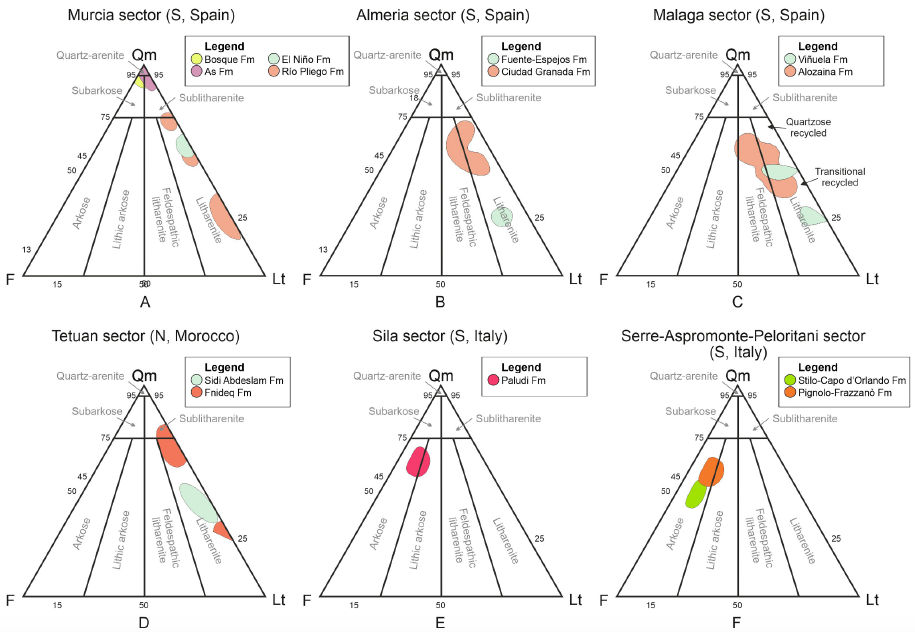
Marked differences have been recognized from western (Betic-Rif) to eastern (Calabria) portions in terms of detritic suites. Detrital suites of the Betic-Rif portions reflect a transition between a craton, transitional and recycled orogenic provenance type. Contrarily, detrital suites of the Calabria portions reflect their transition from transitional continental to basement uplift orogenic provenance reflecting deposition in wedge-top basins during final subduction of the Magrebian-Lucanian-Ionian Basin below the Mesomediterranean and the opening of the Mediterranean basin as a backarc.
Terminology revision of AlKaPeCa and Mesomediterranean Microplate
The use of terms strictly related to the original formulation of different models caused, in some cases, inaccuracies in the univocal identification of some main palaeogeographic elements.
Bouillin et al. (1986) introduced the acronym AlKaPeCa for a lithospherical block formed by Alboran-Kabylian-Peloritan-Calabrian Internal Zones, Alpine units. According to them the relationships between AlKaPeCa and the Maghrebian Flysch Basin may be synthesized as follows:‘ the only possible oceanic zone known between Western Europe and Africa, at the Jurassic time, corresponds to the basement of the Flyschs which was located southward of AlKaPeCa’ .
Many palaeogeographic interpretations of the Jurassic-Cretaceous evolution of the Betic, Maghrebian and Apennine Chains have been roughly grouped into two main general families: (1) Type A models: they state the presence of a single oceanic area (i.e., the Tethys) located between the African and European Plates; (2) Type B models: they consider the occurrence of two oceanic branches of the Tethys surrounding one or more microcontinents located between the African and European Plates. Both classes of models imply a different evolution during the Pangea breakup and during the Cretaceous-Cenozoic convergence. According to Type A models the Pangea broke with a single oceanic branch located between Europe and Africa, meanwhile according to Type B models the fragmentation was more complex leading to two oceanic branches with several microplates located between Europe and Africa.
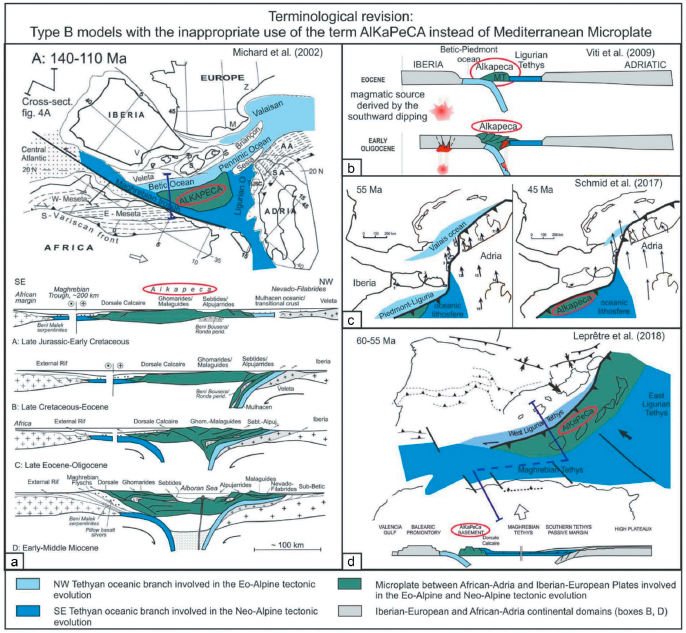
According to Guerrera et al. (2019) the original meaning of AlKaPeCa should be reserved to indicate a detached piece of the European Margin while the Mesomediterranean Microplate should be used exclusively for the independent microplate even though during the Maghrebian- Apennine orogeny these elements actually coincide to form the Internal Zones of these chains. For this reason, the use of this acronym is not appropriate for models which consider the occurrence of an independent microplate surrounded by different oceanic branches of the Tethys since Mesozoic. A more common name used in literature for this microplate is the Mesomediterranean Microplate.
Evolutionary geological models of the central-western peri-Mediterranean chains
Two main groups of geological models presented over the last four decades on the paleogeographic, paleotectonic and geodynamic eo-Alpine and neo-Alpine evolution of the central-western Mediterranean area were compared. The comparison was carried out mainly considering the main stratigraphic, sedimentological, petrographic, structural and plate tectonic constraints. Moreover, recent geophysical interpretations and reconstructions were also considered with an aim of presenting all the different results. The models can roughly be grouped into two main classes. First family considers the presence of the Mesozoic Tethyan Ocean, where a single oceanic basin is located between Africa and Europe and from which both eo-Alpine and neo-Alpine chains were generated during the Cretaceous to Miocene time span. Conversely, the other class considers the occurrence of at least two Tethyan oceanic branches (or with thinned continental crust) since the Jurassic, separated by one or more microcontinents. The pros and cons of both classes of models are presented. Progressive innovations and improvements to the two groups of models were proposed over the years. However, because the modelsare based on different data sets resulting from basic geological studies or obtained by means of other approaches, they often do not integrate easily.This caused interpretative difficulties and terminological uncertainties for their comparison, and completely different models were considered equivalent and, sometimes, the same terminology was used indifferently to identify different geological subjects. The main differences between the examined models concern the kinematic reconstructions and by hence in the paleogeographic and paleotectonic interpretations. The discussion presented in this paper aims at contributing to clarify and update the state of knowledge on this controversial topic.
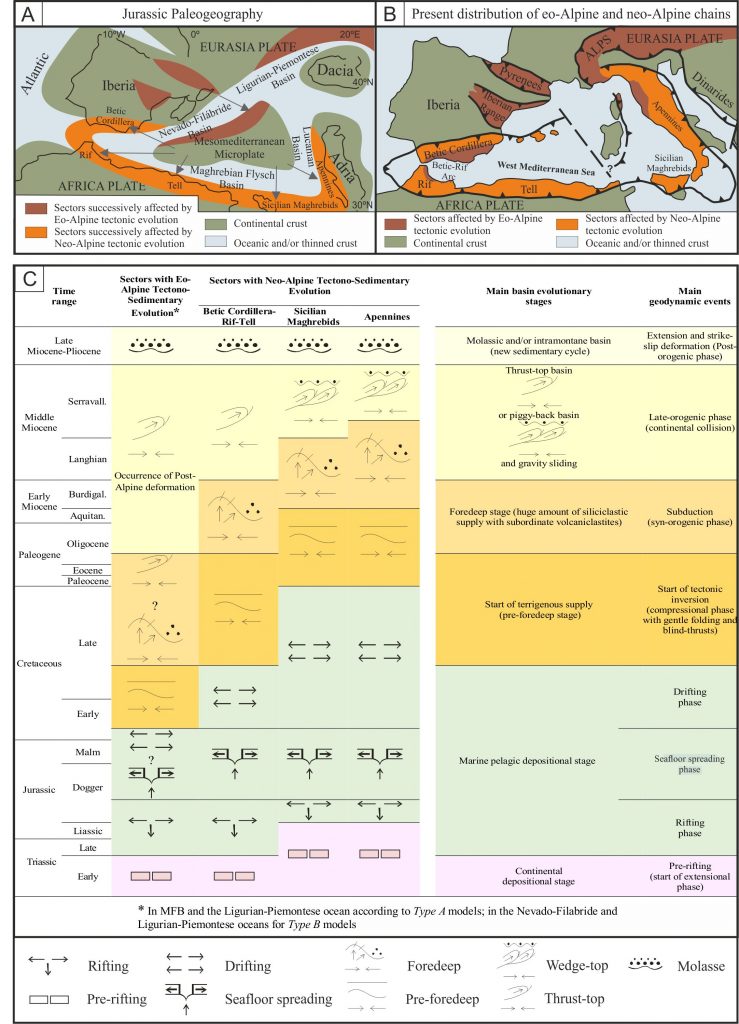
Latest Chattian-Langhian Volcano- Sedimentary Event
High amounts of Chattian-Langhian orogenic magmatism have generated volcaniclastic deposits that are interbedded within the penecontemporaneous sedimentary marine successions in several central-western peri-Mediterranean chains. These deposits are widespread in at least 41 units of different basins located in different geotectonic provinces: (1) the Africa-Adria continental margins (external units), (2) the basinal units resting on oceanic or thinned continental crust of the different branches of the western Tethys, (3) the European Margin (external units), and (4) the Western Sardinia zone (Sardinia Through units). The emplacement of volcaniclastic material in marine basins was controlled by gravity flows (mainly turbidites; epiclastites) and fallout (pyroclastites). A third type comprises volcaniclastic grains mixed with marine deposits (mixed pyroclastic-epiclastic). Calc-alkaline magmatic activity is characterized by a medium- to high-potassium andesite-dacite-rhyolite suite and is linked to complex geodynamic processes that affected the central-western Mediterranean area in the ∼26 to 15 My range. The space/time distribution of volcaniclastites, together with a paleogeographic reconstructions, provide keys and constraints for a better reconstruction of some geodynamic events. Previous models of the central-western Mediterranean area were examined to compare their compatibility with main paleotectonic and paleogeographic constraints presented by the main results of the study. Despite the complexity of the topic, a preliminary evolutionary model based on the distribution of volcaniclastites and active volcanic systems is proposed.

Oligo-Miocene evolution of the Paratethyan branches
A comparison of the stratigraphic record between two different branches of the Tethys is attempted for the first time. This study concerns the main Oligocene-Miocene tectono-sedimentary events in the Cenozoic units of the Moldavidian Basin (Romanian Eastern Carpathians) and the Maghrebian Flysch Basin (Maghrebian Chain and its lateral extension in the Betic and Southern Apennine Chains). Both basins are characterized by three main general Oligo-Miocene successions (internal, mixed, and external) corresponding to three subdomains controlled by the geological evolution of opposite plate (or microplate) margins and affected by a similar tectonic evolution. The successions of the three subdomains of the two basins show very similar features regarding stratigraphic records (lithofacies and petrofacies associations, unconformities, marker-levels, age), and the space-time sediment supply diversification (i.e., immature and super-mature arenites coming from opposite margins). Furthermore, pre-, syn- and post-orogenic successions have been identified in the geological reconstructions of both basins. The tectonic control on depositional processes (i.e., a large amount of siliciclastic supply confined in restricted time ranges, widespread volcaniclastites linked to acid-intermediate penecontemporaneous volcanic activity), and the appearance of indicators of syn-sedimentary tectonic activity (turbidites, slumps, and olistostromes) result in correlable events related to deformation phases that in turn are indicative of a similar evolution. Also, the basinal evolutionary stages (i.e., beginning of terrigenous supply, thrust-top basin formation and gravitational sliding, molassic and/or intramontane sedimentary cycles), the timing of deformation phases (drifting, foredeep), and geotectonic events (from extension to compression and post-orogenic deformation) seem to be similar. All results are encompassed in an evolutionary geodynamic model considered in the context of the Africa-Europe convergence where intermediate microplates are involved. This complex framework implies a progressive reorientation of convergence direction of these microplates that occurs during similar geodynamic events leading to the closure of the western Tethys Ocean and its related late-Alpine branches. This comparative approach, if applied to similar evolutionary phases of other mountain chains, can be useful for different geological contexts of other orogenic belts, especially to check the major general geological constraints for their evolution.
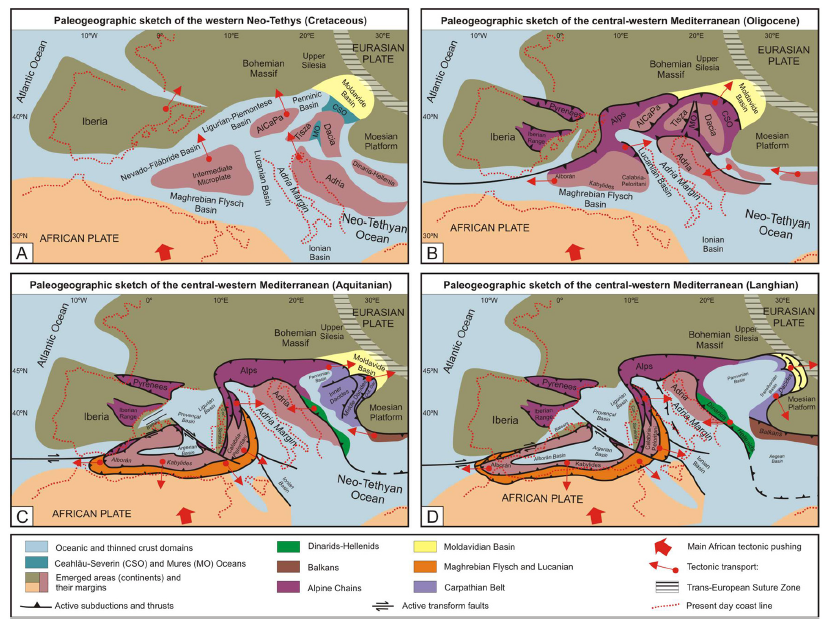
Nearshore Mid-Triassic Zoophycos
Zoophycos is a well-known trace fossil common throughout the Phanerozoic. Paleozoic forms show important differences in morphology and habitat distribution with respect to the Jurassic, Cretaceous, and Cenozoic ones. Therefore, Early–Middle Triassic is considered a crucial time-span for the understanding of the evolution of this trace fossil. So far, Early Triassic Zoophycos is unknown and Middle Triassic forms were recorded only in deposits from Thuringia. The morphology and paleoenvironment of Zoophycos from the middle–upper Muschelkalk of the Iberian Range is herein described.
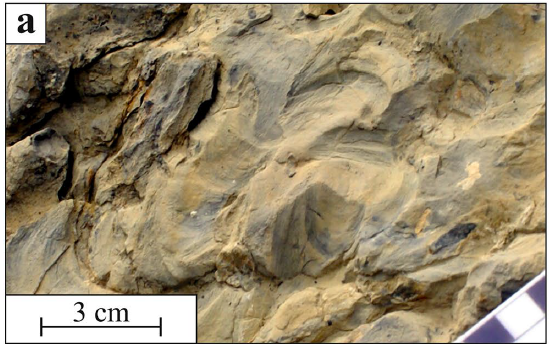
The best-preserved trace fossils occur in a dolomicritic bed Ladinian in age, and are represented by small forms with a subcircular, slightly lobed outline and very little penetration depth. They were deposited in a very shallow, quiet-water environment with transition to supratidal/emerged areas. The low diversity of both trace fossils and skeletal remains point to stressful conditions related to strong salinity variations and/or poor water circulation. A comparison was made with Zoophycos from Anisian deposits of the Muschelkalk in Germany. This showed that both forms are quite simple and penetrate only the shallowest tiers, although they are different in whorl outline and lobe shape.
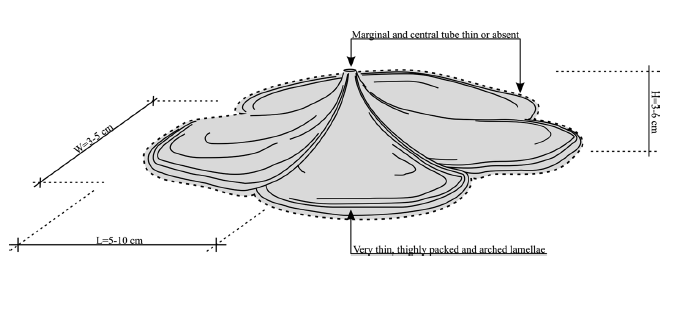
This confirms that, notwithstanding the morphological variability of this group, Zoophycos still maintained a quite simple structure in the Triassic. A shallow-water environment was deduced for both localities, confirming that at least until the Early Jurassic Zoophycos had not definitively migrated toward deep-water areas.
Cite as: Giannetti, A., Tent-Manclús, J. E. y Baeza-Carratalá, J. F. (2017): New evidence of nearshore Mid-Triassic Zoophycos: morphological and paleoenvironmental characterization. Facies, 63,16: 1-12. DOI : 10.1007/s10347-017-0498-8
Tethyan to Mediterranean Evolution
Message from the Guest Editor
Dear Colleagues,
Several geological modeling studies on the geodynamic and paleogeographic Alpine (Eo-Alpine during the Cretaceous–Paleogene; Neo-Alpine during the Oligocene– Miocene) evolution of the Mediterranean have been published without consensus in the last four decades. Therefore, a Special Issue dedicated to “Tethayan to Mediterranean evolution” seems justified. Studies that consider the geodynamic and/or paleogeographic evolution of the entire Mediterranean area or a part of this area will be welcome. The proposal can be focused on stratigraphic, sedimentological, petrographic, or tectonic data, or geophysical interpretations and reconstructions based on principles of Plate Tectonics using GPlates or similar software. The papers that are published in this Special Issue can contribute to clarifying and updating the state of our knowledge about this controversial theme.
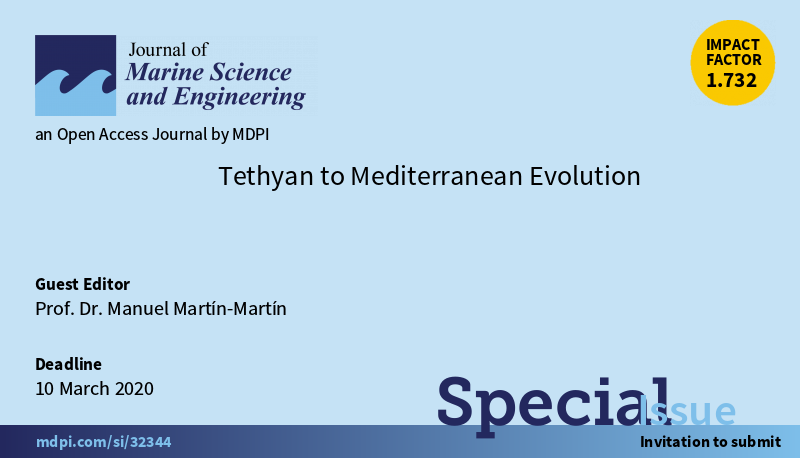
Message from the Editorial Board
T h e Journal of Marine Science and Engineering (JMSE; ISSN 2077-1312) is an international peer-reviewed open access journal which provides an advanced forum for studies related to marine science and engineering. The journal aims to provide scholarly research on a range of topics, including ocean engineering, chemical oceanography, physical oceanography, marine biology and marine geosciences. We invite you to publish in our journal sharing your important research findings with the global ocean community.
Open Access: free for readers, with article processing charges (APC) paid by authors or their institutions.
High visibility: Indexed in the Science Citation Index Expanded in Web of Science, in Inspec (IET) and in Scopus.
CiteScore (2018 Scopus data): 1.76, which equals rank 30/92 in ‘Ocean Engineering’, rank 105/288 in ‘Civil and Structural Engineering’ and rank 77/203 in ‘Water Science and Technology’.
Guest Editor:
Prof. Dr. Manuel Martín-Martín
Earth sciences and environment
Department (University of Alicante). Campus Universitario del San Vicente del Raspeig, AP- 99, 03080 Alicante, Spain
manuel.martin.m3@gmail.com
Deadline for manuscript submissions:
10 March 2020
Recent Comments